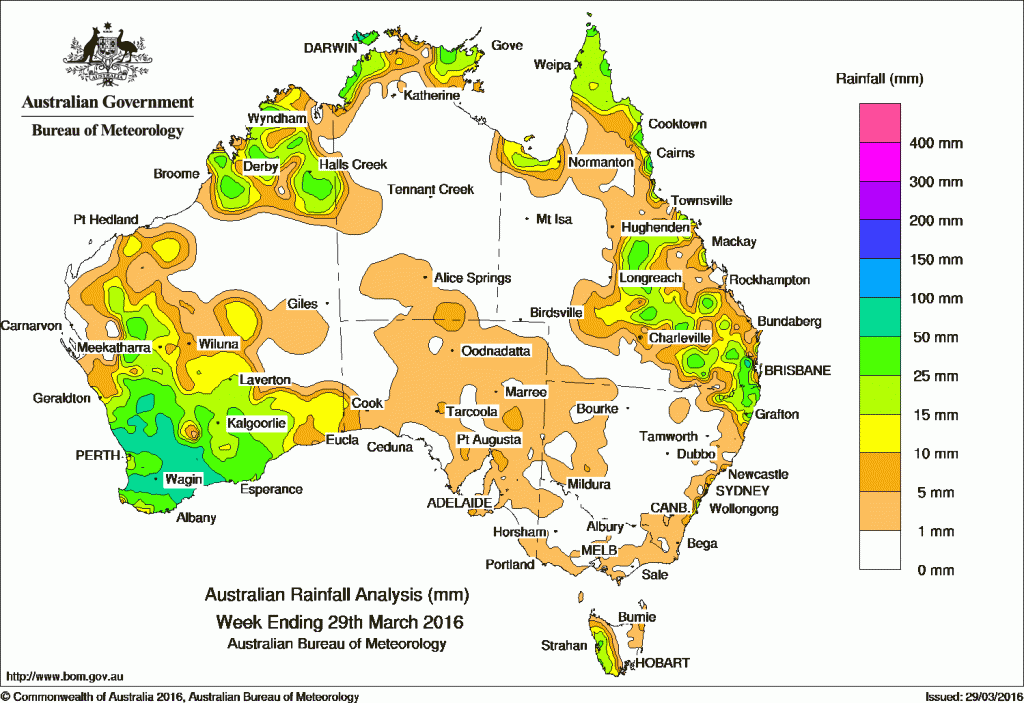For the week to 29 March 2016, rainfall was recorded in Western Australia, the Top End of the Northern Territory, and Queensland. Moderate rainfall was also recorded along coastal New South Wales and western Tasmania.
At the beginning of the week, an upper level cloud band associated with a trough streamed across southwest Western Australia, generating areas of rainfall along the State’s southern coasts, while a broad trough produced large areas of cloud with embedded thunderstorm activity in the Kimberley district.
Moderate falls were recorded along central and northern parts of coastal Queensland as an upper level trough moved away from the eastern seaboard.
In the middle of the week, an extensive cloud band of tropical origin moved through western and southern parts of Western Australia producing widespread moderate to heavy rainfall from inland Pilbara and Gascoyne to the South West Land Division.
A surface trough extending from the Gulf Country in Queensland with an embedded low centre near inland northeast New South Wales, resulted in moderate falls in the Gulf Country coast, and from Queensland’s Central Highlands and Darling Downs districts to northeast coast in New South Wales. Mainly light rainfall was recorded along the west coast of Tasmania and coastal Victoria as a cloudband and a weak cold front moved through the regions.
In the last part of the week, light to moderate rainfall was recorded in southern parts of Western Australia as the weakening cloud band moved eastward. Light to moderate rainfall was recorded along the New South Wales coast as a low pressure trough extends from the State’s northeast into the Tasman Sea.
Rainfall totals between 50 mm and 100 mm were recorded in southwest Western Australia, with some locations recording totals in excess of 100 mm. Small areas along the New South Wales coast, Queensland’s tropical north and southeast coast, as well as the far northwest of the Northern Territory also recorded rainfall totals over 50 mm. The highest weekly total was 121 mm at Ravensthorpe in south central Western Australia.
Rainfall totals between 25 mm and 50 mm were recorded in in Western Australia including the Kimberley, inland Gascoyne and the South West Land Division, the northern Top End of the Northern Territory and some areas of Central Highlands and southeast and coastal districts of Queensland. Similar totals were recorded in parts of northeast New South Wales and the southwest of Tasmania.
Rainfall totals between 10 mm and 25 mm were recorded in parts of the northern tropics, much of the southern and central districts of Western Australia, western Tasmania and coastal New South Wales.
Most of the Northern Territory, western to central Queensland, most of inland New South Wales and Victoria, eastern Tasmania, and South Australia recorded little or no rainfall this week.
Highest weekly totals by State/Territory
New South Wales and ACT
119 mm Bellambi Aws
97 mm Culburra Treatment Works
69 mm Baryulgil (Clarence River)
Victoria
12 mm Reeves Knob, Mount Baw Baw
6 mm Multiple locations
Queensland
89 mm Somerset Dam
87 mm Double Island Point Lighthouse
Western Australia
121 mm Ravensthorpe
117 mm Wyalkatchem
106 mm Goomalling
South Australia
8 mm Mount Dare, Wirrabara, Jamestown Pirsa
Tasmania
53 mm Mount Read
32 mm Queenstown (South Queenstown)
25 mm Zeehan (West Coast Pioneers Mu
Tim Shea (Summit)
Northern Territory
74 mm Pirlangimpi Airport
65 mm Csiro Berrimah
54 mm Mcminns Lagoon
More weekly rainfall totals:
- NSW/ACT totals click here
- Vic totals click here
- Qld totals click here
- WA totals click here
- SA totals click here
- Tas totals click here
- NT totals click here
Source: BOM




HAVE YOUR SAY